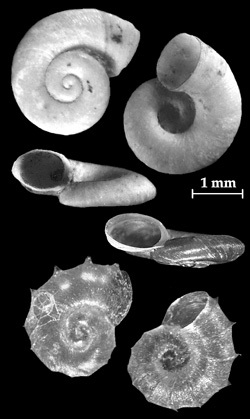This page of the guide is concerned with two separate genera which are unlikely to be confused, except for their very small size – under 3 mm. in breadth.

Gyraulus crista
(Linnaeus, 1758)
Gyraulus crista (Linnaeus, 1758)
Description: The shell is thin, not glossy, and horn coloured. The spire is extremely sunken, so much so that it would be thought to be a wide umbilicus if one did not realise that the shell is sinistrally wound. The true umbilicus is, in fact slightly raised! The shell bears strong transverse ridges at regular intervals. In the varieties nautileus, cristata and spinulosa the transverse ridges are produced into points at the periphery. These are of different lengths and spacing, according to the variety. The body whorl is bluntly angled below, and the mouth aperture is oval.
Size: Height: 1 mm. Breadth: less than 3 mm.
Habitat: It is common on the leaves of water plants throughout the British Isles.
Click here to see other species of the genus Gyraulus

Menetus dilatatus
(Gould, 1841)
Genus: MENETUS H. & A. Adams, 1855
Only one species of this genus occurs in northern Europe and that is an introduction from North America which has become naturalised.
Menetus dilatatus (Gould, 1841)
Description: The shell is small, yellowish-green in colour, with only 2½ whorls which have a minutely wrinkled appearance caused by the growth lines. The spire is very intorted and the mouth aperture is very wide and expanded, giving the shell a very distinctive appearance.
Size: Height: 1 mm. Breadth: 2 – 3 mm.
Habitat: This is a North American species that has become naturalised in a few canals around Manchester and Burnley and in Cheshire.
